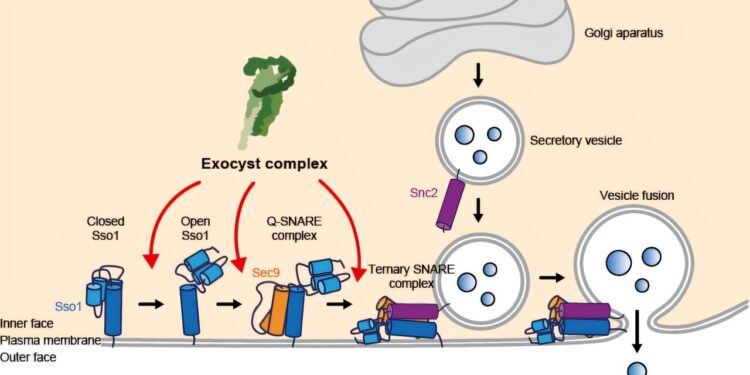The role of the exocyst in exocytosis. Credit: Seung-Hak Lee, medical student, School of Biological Sciences and Institute of Molecular Biology and Genetics, Seoul National University, Seoul, South Korea
A new study highlighting the importance of a large protein complex called the exocyst in cell growth, division and communication reveals new functions and mechanisms essential to how molecules move across a membrane through cell vesicles. a cell.
Understanding how these mechanisms function in normal cells at the basic biological level will inform future research into how these functions are disrupted in developmental and neurological disorders.
“This is the first time a membrane fusion role has been described for this complex and is a major advance in how we think about how the exocyst complex works,” said Mary Munson, Ph.D., professor and vice president for diversity in the Department of Biochemistry and Molecular Biotechnology, associate vice provost for science equity in the Office of Health Equity.
Munson is co-corresponding author of the study published in Nature Structural and molecular biology.
The research was carried out in collaboration with Tae-Young Yoon, Ph.D., professor of biological sciences in the School of Biological Sciences and the Institute of Molecular Biology and Genetics at Seoul National University, Korea South.
“Until our collaborative study, it was understood that the exocyst recognizes and possibly attaches secretory vesicles to the cell membrane, prior to exocytosis. In this study, we reveal biophysical studies that indicate that the exocyst plays multiple roles critical that directly facilitate the fusion of vesicles with the cell membrane to facilitate cargo delivery,” Dr. Munson said.
Tight control of exocytosis is essential for all cells to grow, divide and communicate properly. Dysfunction of exocyst regulation has been associated with numerous physiological problems in different organisms.
“This is really an exciting development in our field, because the exocyst complex has not previously been shown to directly control vesicle fusion,” Dr. Munson said. “The complex recognizes the right vessel, the right place on the cell surface and the right time for the cargo to be delivered. It does this by talking to the membrane fusion protein.”
More information:
Chanwoo Lee et al, Exocyst stimulates several steps of exocytic SNARE complex assembly and vesicle fusion, Nature Structural and molecular biology (2024). DOI: 10.1038/s41594-024-01388-2
Provided by University of Massachusetts Medical School
Quote: Exocyst study reveals new roles for protein complex in membrane fusion (January 14, 2025) retrieved January 14, 2025 from
This document is subject to copyright. Except for fair use for private study or research purposes, no part may be reproduced without written permission. The content is provided for informational purposes only.



